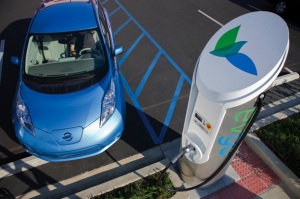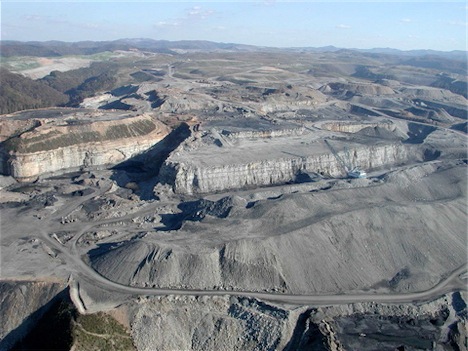![]() Tweet Will moving to the new energy future – deploying Solar, Wind and other sustainable alternatives create 2.7 Million New Jobs?
Tweet Will moving to the new energy future – deploying Solar, Wind and other sustainable alternatives create 2.7 Million New Jobs?
At “How Cities and Companies Can Work Together to Operate in the New Energy-Constrained Economy” a panel discussion (press release), Bruce Katz, Vice President and Director of the Metropolitan Policy Program, Brookings Institution, said “2.7 million new jobs” will be created in moving to the clean energy / low carbon economy.
Mr. Katz also noted that two out of three Americans – 200 million people – live in the 100 biggest metropolitan areas, and those 200 million people are responsible for 75% of our GDP. High carbon energy is no longer cheap. The people in those metropolitan areas, and elsewhere, therefore, must act.
Mr. Katz joined David Bragdon, New York City’s Director of Long-term Planning and Sustainability, (NYC / Mayor’s Office / PlaNYC), Steve Corneli, Senior Vice President for Sustainability, Strategy and Policy, NRG Energy, and Scott Bolick, Vice President, Sustainability Solution Management, SAP, for a 90 minutes to discuss:
- The programs and initiatives cities, municipalities and corporations have in place to reduce energy usage, while remaining competitive.
- The role of technology in reducing energy use.
- The impact on local businesses, both commercial and manufacturing of a transition to a low carbon economy.
- The role of utilities in creating a more energy-efficient and competitive environment.
One take-away: it’s not only treehuggers and people with an MBA in “Sustainability,” such as from Bainbridge Institute, The Fowler Center at Case Western, Marlboro College, the Presidio. People at places like the Brookings Institution, the City of New York, the Pentagon, energy companies like NRG Energy, and companies like SAP, Ferrari, and WalMart are asking these questions.

by Sunoptics, used to provide illumination and lower electricity demand. This photo was taken in a retail space at 7:00 PM on a cloudy day. L Furman, 6/26/11.
Journalists and bloggers were invited to listen to the panel and ask questions. I was invited as a blogger thanks to my work on 3BL Media and here on Popular Logistics. In addition the panelists and organizers, I met people from Forbes, Scientific American, Green Biz, and Climate Central. The event worked very well as a panel discussion / lecture / seminar. While I would have gladly spent more time networking with journalists and other bloggers, this did not serve as a networking event.
Mr. Corneli is enthusiastic about electric cars. This is not surprising: he’s from NRG – a company that generates and sells electricity. He spoke of the NRG electric car program in Houston (See also Christopher Helman, in Forbes / Bailey McCann in Civsource). While electric engines are more efficient than internal combustion engines, electric cars can be only as clean as the electricity that powers them, and you must factor in the loss in energy as the electricity is moved across transmission lines. I think an internal combustion engine is about 15% efficient in turning hydrocarbons into power to transport people. A coal plant is about 33% efficient in turning coal into electricity. There are also line losses – about 7 to 10 percent – in transmission. So an electric car engine is about 31% efficient. (93% times 33% equals 30.69%.) Of course, to get a complete picture we need to consider the logistics and the supply chain. Fuel must be extracted, process, and transported. Gasoline must be transported from well to refinery to gas pump, and coal must be transported from mine to plant. We get gasoline from deep under the Gulf of Mexico (think Deepwater Horizon), Canadian tar sands, or our good friends in Saudi Arabia, and Venezuela. I think we bought oil from Iraq in the ’80’s and ’90’s. Alan Greenspan once described the war in Iraq as a ‘War for Oil’ (here). We get coal by blowing up mountains – literally – in West Virginia. While blowing up mountains is bad for the environment, it’s West Virginia, not a foreign country with foreign policy goals and interests that might be different from ours. But I digress.
The discussion was interesting, productive. Here are some other take-aways:
- Energy is a socio-economic and national security issue. It is not a political issue, it is not left or right, Democratic or Republican, Socialist, Communist, or Capitalist.
- Climate change is real and anthropomorphic. The evidence is developed via scientific means, and by answering the questions regarding happens when you move 500 billion tons of carbon from underground, where it is stored as coal, oil, or methane, into the atmosphere in the form of carbon dioxide? What happens when you (we) increase the concentration of carbon dioxide in the atmosphere from about 280 ppm in 1800 to about 390 ppm today to about 450 ppm in the not-too-distant future? (This should not be a political issue. It should not be left or right ….)
- Tomorrow’s economy will be constrained by energy and resources. And those constraints are beginning.
- Some people are acting, others are in denial. The people who act sooner will be better positioned than those who act later, and those who are in denial. This also holds for companies and nations.
- This paradigm shift to a low carbon economy could create 2.7 million jobs in the USA, quickly.
Mr. Katz said we are facing a “disruptive moment.”
“Our economy has been driven by exports and innovation,” he continued, ”We also must transition to a low-carbon energy. Carbon based energy is no longer cheap. The US doesn’t look at energy from within a strategic framework. We must. It’s a fiscal imperative. ”
David Bragdon, New York City’s Director of Long-term Planning and Sustainability, agreed. Clean water is expensive. Waste disposal is even more expensive. David spoke about PlaNYC . Like the system pictured above on the Whitehall Street terminal of the Staten Island Ferry, the City is planning on large PV Solar installations on closed landfills in Staten Island and Brooklyn and considering wind turbines where the winds are strong. The City should perhaps consider a solar array on the public schools, high schools and park buildings, and various campuses of City University of New York, and other public buildings. It could also consider a small battery of wind turbines offshore of Staten Island, Brooklyn, and Queens.
Had I been invited to participate as a speaker, I would have discussed the feasibility study I wrote on the logistics, economics, and finance of 152.5 mw of PV solar on the public schools, community colleges and universities in New Jersey (Press release here).
I would also have repeated the bold strategic challenges issued by Al Gore in 2008: “100% clean electricity in 10 years,” and Barack Obama in 2011: “80% renewable energy by 2035,” and outlined my response:
- 100 gw landbased wind
- 100 gw offshore wind
- 50 gw pv solar
- 50 gw deep geothermal
- 100 giga-nega-watt-equivalents of efficiency.
As a listener, I asked about comparing wind and solar to nuclear and coal. “There are no fuel costs associated with wind and solar, and there are no waste management costs,” I said. “The economic externalities of wind and solar are less than nuclear and coal – even without Fukushima, Deepwater Horizon, Upper Big Branch, Kingston Steam Plant coal ash pond flood – how do we price externalities into the model?”
This sparked a dialog on the economic externalities of new plants against old plants that have been operation 30 or 40 years – that have been paid for – and can be kept running, albeit inefficiently?
A consistent theme on this blog has been the role of the government and comparisons of solar and wind to coal, oil, and nuclear. If we take out the subsidies for solar should we not consider social costs and cleanup or waste management costs for coal and nuclear? How do we price or value national security implications of these technologies?
While the economic externalities of non-sustainable fuel based energy paradigm create costs, which add to GDP, the economic externalities of sustainable energy create assets, which may reduce Gross Domestic Product, GDP, but increase the Genuine Progress Indicator, GPI. For example offshore wind farms create artificial reefs, which nurture fish and birds. Rooftop solar arrays shade the roof of the buildings on which they are mounted – preserving the life of the roof and lowering cooling requirements. While new nuclear and coal with sequestration cost more than new wind and new solar, existing coal and nuclear plants have been amortized and therefore appear to be less expensive to run than new wind and solar.
It is easy to say “We need to end our reliance on coal and nuclear, and move to solar, wind, geothermal, efficiency, and other alternatives.” Consider business as usual – mountaintop mining – and business as unusual – coal ash spills, floods at nuclear power plants, etc. It’s easy to conclude that we must. Meanwhile, Mr. Corneli and his colleagues at NRG Energy generate power for about 52 million people in about 20 million households. NRG and other companies in its sector generate power for 307 million Americans. Changing the energy mix can not happen overnight. We can’t simply shut down all the coal and nuclear power plants and all the oil refineries. Shifting the paradigm will take work, time, and money. Still, Germany is doing it, and we can do it to. And if Mr. Katz, Mr. Bragdon, and others (including this blogger) are correct this will stimulate the economy in ways that are good for society, our children, and the economy as measured by GPI (if not GDP). (Click here for “My Metric is Better than Your Metric,” a comparison of GDP and GPI.)
Personally, I think the government must make policy decisions to catalyze a transition to a clean sustainable economy. To extend Adam Smith’s canonical metaphor, “The invisible mind of society must direct the invisble hand of the market so it doesn’t shoot itself in the invisble foot of the bio-humano-sphere.”
—
This is the first post in a series. The next will explore the macroeconomic impacts of 2.7 million new jobs on the economy and the bio-eco-econo-system that is the United States. Others may explore how power companies view sustainability, how SAP is cutting its carbon footprint and helping other companies cut their carbon footprints, the highlights of PlaNYC, and sustainability plans of cities as diverse as Chicago, Illinois, New Bedford, Massachusetts, and Brattleboro, Vermont. However, the constraints of spare-time blogging are such that there are more posts that could be written than actually get written.


